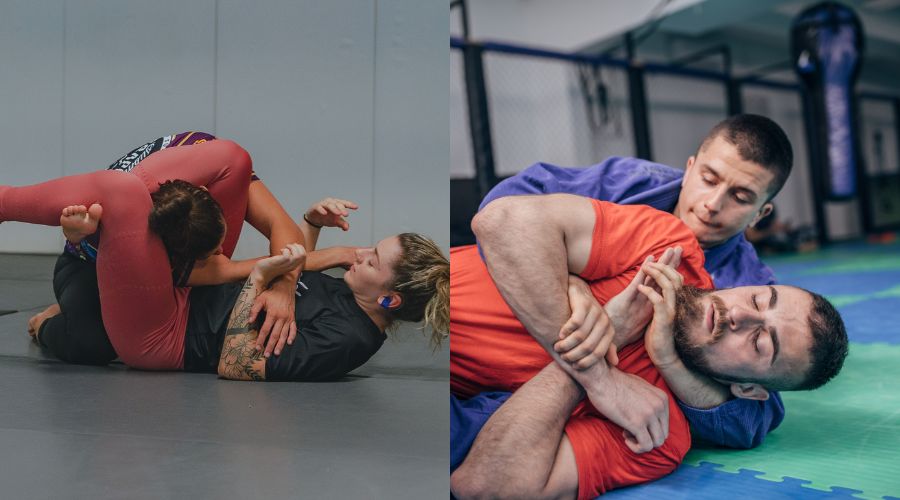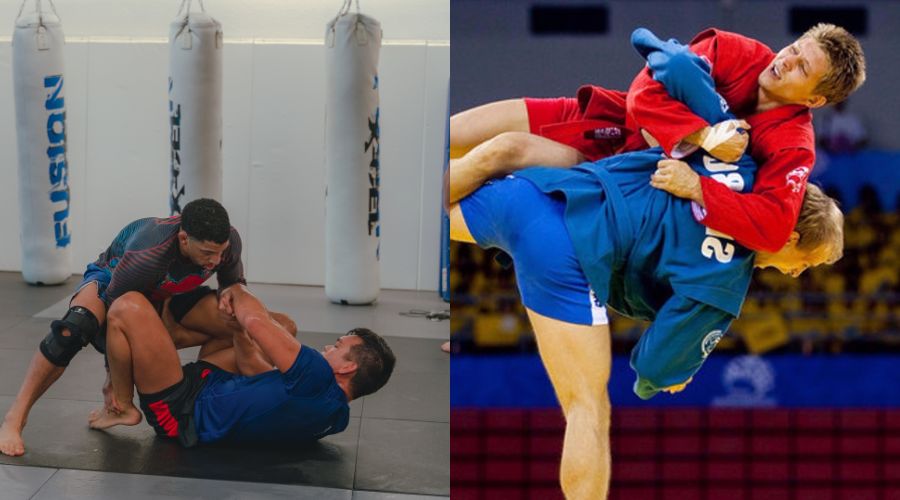In BJJ and Sambo, two deadly martial arts are proven in MMA, real-life situations, and sports competitions. Both have excellent arguments for superiority, and each has strong sides and flaws. But what is the difference?
Sambo was created as a hand-to-hand military system with highly effective and intense striking, wrestling, and grappling techniques. This is known as combat sambo in its competition variant, while sports sambo is a purely grappling combat sport.
Brazilian jiu-jitsu, on the other hand, is a complex grappling system developed for self-defense that has evolved into an essential component of MMA and a separate grappling-only sport.
BJJ and Sambo were created in the same period but in different places and with different goals. Knowing what makes each good and the difference is essential in choosing which to train or what to expect from opponents trained in BJJ or Sambo.
What Is BJJ
BJJ is a comprehensive grappling martial art and combat sport emphasizing ground fighting. The main goal of BJJ is to force the opponent to submit through joint locks and chokes. BJJ operates through positioning and leverage to allow much smaller people to dominate larger opponents.
The main people behind Brazilian jiu-jitsu are the Gracie family. The brothers Carlos and Helio started learning judo techniques from a master named Mitsuyo Maeda, who traveled to Brazil to spread the new martial art of judo, then called Kano jiu-jitsu. The Gracies developed and perfected the ground portion of the system to the point where it became a new martial art altogether.
BJJ grew slowly in popularity until the early 1990s when the inaugural UFC events showed the world how important grappling is to a real fight. BJJ quickly gained popularity as a crucial element of mixed martial arts and as a separate, highly complex grappling-only sport that gathers more practitioners daily.
What Is Sambo
Sambo is a combat system developed for military use during the Soviet era in Russia. It has two primary distinctive forms. Combat sambo, which allows striking, grappling, and mixing the two. And sports sambo, which is a grappling-only sport resembling judo.
Viktor Spiridonov and Vasil Oshchepkov worked independently to develop Sambo as a comprehensive fighting system by combining effective techniques from various martial arts. Judo became the backbone of Sambo, but many other techniques and tactics were implemented.
Combat sambo was reserved only for the military and special forces for many years. It was not taught to regular citizens, who could only learn sports sambo. Still, by the end of the 1980s, combat sambo had reached the main population.
Combat sambo is an excellent base for MMA due to the mix of striking and grappling and has been made popular worldwide by the legendary careers of MMA fighters like Fedor Emelianenko, Khabib Nurmagomedov, Oleg Taktarov, and others.
Key Differences Between BJJ & Sambo

Rules and Tactics
We’ve talked many times about how the rules of a combat sport ultimately determine all other specifics, including tactics.
BJJ, as a sport, is pure grappling and does not allow any form of striking, slams, suplexes, or heavy throws. The goal of the match is to submit the opponent through a choke or joint lock or accumulate more points by securing dominant positions.
Takedowns are not scored highly and can easily be negated by doing a sweep on the ground, making them not very important. Compared to other grappling sports, having your back on the ground is okay. Working from a full guard is even a preferred position for some BJJ players. Here is how points are scored in sports BJJ:
- 2 points- takedown, sweep, or knee to the belly position.
- 3 points- passing the opponent’s guard
- 4 points – mount or back mount positions.
More recently, another style of BJJ has been developed called no-gi. The big difference is competitors do not wear the traditional gi but shirts and shorts, which are not allowed to be held or manipulated, making it more similar to grappling in MMA.
Both sambo rulesets are different from BJJ. In sports sambo, the way to win the match directly is by throwing the opponent on his back while remaining standing, pinning him to the ground, or submitting him using a legal joint lock.
Chokes are not permitted in sports sambo. This variant is similar to judo but with fewer restrictions on legal moves. Sambo aims to win as quickly as possible, and positioning is less important than in BJJ.
Combat sambo also allows diverse striking techniques, including punches, kicks, knees, elbows, and even head butts. However, they do not score any points and are used to hurt the opponent, send him to the ground, or set up a takedown because the ways to win are the same as in sports sambo, but with very few prohibited techniques both on the feet and on the ground.
Here is how points are scored in combat sambo.
- 4 points- Knockdown
- 1-4 points -Throws (depending on the quality of the throw)
- 2-4 points – Pins (depending on the length of the pin)
Techniques
BJJ has a vast array of submissions, which are the main arsenal of the sport. These include joint locks, chokes, strangles, neck cranks, and painful movements. Some submissions, like leg locks, are forbidden for some ranks, but there are very few limitations at the high level.
Positions are crucial in BJJ, and a lot of attention goes to having the skills to acquire dominant positions and escape bad ones. The positions include various forms of guards, side control, mount, back control, sweeps, and transitions between them.
As previously stated, takedowns play a lesser role. Still, wrestling moves such as single and double-leg takedowns, trips, and the unique BJJ tactic of “pulling guard” are used to bring the fight to the ground.
Throws are crucial in sports sambo and take center stage. Many of judo’s most famous throws and trips are used in Sambo. Still, wrestling takedowns and other sambo-specific ways to take someone to the ground are also employed.
Chokeholds are forbidden in spots Sambo, but leg locks are not, and sambists are specialists. Also used are straight arm locks and pinning techniques.
Combat sambo, on the other hand, has very few limitations. In addition to all the possible takedowns and throws, it has striking with all body parts. In fact, combat sambo has perhaps one of the most liberal rule sets, even more so than modern MMA, so the techniques and combinations between them are too vast to list.
Equipment
BJJ and Sambo have, at least partially, similar uniforms. BJJ uses a gi derived from the traditional Japanese kimono, which consists of a heavy jacket, long pants, and a colored belt denoting the rank of the practitioner. The only protective piece of equipment is a mouthguard.
Then there is another form of BJJ that is practiced without a gi called no-gi BJJ, where grapplers wear tight shirts, ideally a BJJ rash guard, and shorts or spats.
The kurtka, or sambo jacket, is similar to the one worn in BJJ and judo, but sambists wear tight compression shorts instead of long pants.
Wrestling shoes are also used in all forms of Sambo. Here is the complete list of combat sambo equipment. The sports version uses the same things but without the gear required for striking.
- Jacket (Kurtka, Sambovka)
- Mouthguard
- Wrestling style shoes
- Boxing helmet
- Shin guards
- MMA type gloves
BJJ vs. Sambo For MMA

No one can argue against the stellar results BJJ has produced in MMA. Since the very start of the UFC, jiu-jitsu has been the preferred grappling style of many great champions. But combat sambo is just tailor-made for MMA.
While BJJ lacks striking and must be more heavily adapted to cage fighting, combat sambo already has punches, kicks, knees, and elbows, as well as a mix of the two both on the feet and on the ground, making it as close as possible to MMA even if the focus is different.
But BJJ has a much broader reach and academies worldwide. So far, more MMA fighters use it, and only wrestling has produced more MMA champions than BJJ. Jiu-jitsu is fundamental to mixed martial arts that each fighter must study.
Combat sambo has had fewer big names, but it has produced some of the most dominant MMA champions, including the great Fedor Emelianenko, Khabib Nurmagomedov, and Islam Makhachev. In direct comparison, combat sambo is superior to BJJ for MMA because it encompasses all aspects of fighting.
BJJ vs. Sambo For Self-Defense
BJJ was developed for self-defense to use technique rather than strength, allowing physically weaker people to defend themselves against stronger ones. On the other hand, Sambo was created for battlefield use and is more brutal, fast-paced, and physically demanding.
Furthermore, Sambo emphasizes the importance of ending the fight as quickly as possible, making it ideal for street fights’ intense and brutal nature. Add to that the striking and grappling, and it is easy to see why the versatility is better for self-defense than the pure grappling-oriented nature of BJJ.
But if you are not physically gifted, BJJ will give you many more options for winning. This was, after all, the initial goal. Because of the large number of positions and submissions, BJJ is also better for resolving situations with less violence, which is a big plus in real life where there are laws.
Overall, both Sambo and BJJ are great for self-defense. They have different strengths and are better for different people and situations. They both include a lot of sparring and drilling against fully resisting opponents, which is the best way to prepare you for real altercations.
Who Would Win A Fight Between BJJ and Sambo?
Combat sambo will almost certainly win a no-rules fistfight. BJJ is at its strongest on the ground, where it can negate strength disadvantages or the chance of a lucky punch landing. And against pure strikers, it is almost flawless.
But sambist also know how to handle themselves in grappling. While their ground game may not be as elaborate, adding striking on the feet and while on the ground drastically changes the game and tips the scales heavily in their favor.
In pure grappling, though, BJJ has the advantage, again depending on the rules. With big throws and slams, Sambo more than holds its own, but still, the BJJ ground game is much more complex and elaborate. The ADCC, which is the Olympics of grappling and has been dominated by BJJ athletes, is an excellent example of this.
Here is a lengthy example of grappling matches between the two styles:
Can You Use Sambo In BJJ?
Combining Sambo and BJJ is an excellent idea, and there are things in the Russian martial art which will benefit your BJJ game. Various takedowns and trips can help you decide when and how the match will go to the ground.
Then, leg locks in Sambo are at a very high level, and if you are at a level of BJJ where you are allowed to do them, the skills transfer is invaluable.
But many things that are great in Sambo for MMA or self-defense are not allowed in BJJ, so you need to be careful. Strikes, slams, and big throws common in Sambo are all quick ways to get disqualified from BJJ competition.
So while there are crossover skills from Sambo to BJJ, you must first analyze what you can use and what is forbidden.
To finalize the article, here is another video of some key differences between BJJ and Sambo explained by high-level practitioners:
